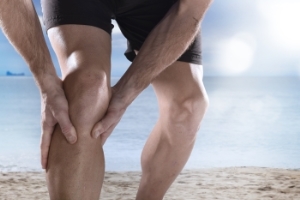
Not as common as isolated ACL or MCL injuries, but they can wreak just as much havoc on the knees.
The collateral ligaments can be found on either side of the knee, with the MCL (short for medial collateral ligament) on the inner side and the LCL (short for lateral collateral ligament)on the outer side. You can think of the MCL and LCL as the knee’s stabilizers, providing for some of the knee’s ability to steadily rotate sideways without buckling, while also bracing it against unnatural movements. Although ligament sprains are the most common type of knee injury, isolated (only the ligament involved was injured) sprains usually happen more often to the ACL or MCL, which in turn get most of the attention.
However, isolated LCL injuries do occur and are usually the result of an excessive force or direct impact to the inside of the knee that pushes it outward and sideways. This force can be brought on by play in collision sports like football, soccer, and ice hockey, for example, but they also happen in skiing and ice skating athletes, where the risk of high torque force to the knee is also present. As would be expected, the most common initial symptom of an LCL injury is the presence of pain at the outside of the knee. This pain may be accompanied by swelling and instability, or a feeling that the knee is “giving out.”
When assessing a patient for a suspected LCL injury, a doctor will perform a physical examination to evaluate the injured knee and compare it to the non-injured knee. He or she may also order imaging examinations including X-ray or MRI, to determine the extent of the injury and to see if any other knee structures were injured during the incident.
As is the case with other ligamentous injury types, LCL injuries are referred to as “sprains,” and a grading scale of severity is applied to them. Grade 1 sprains involve mild damage to the ligament but present with no apparent instability or gapping of the joint when a stress test is administered. Grade 2 sprains indicate a partial joint gapping or “tear” of 5-10 mm upon stress testing with the knee at a flexion of 30 degrees. Finally, grade 3 LCL sprains indicate wide gapping of more than 10 mm with the knee at 30 degrees of flexion. Grade 3 sprains are considered “complete” tears, with the LCL splitting into two pieces and rendering the knee joint unstable.
Treatment for injury to the LCL depends on the grade but customarily begins with non-surgical options including ice, bracing, and physical therapy. Ice therapy is intended to help reduce swelling and inflammation the injured ligament while bracing helps to protect the injured knee against further damage from the sideways force that caused the initial injury. Physical therapy can also be an extremely beneficial treatment option to help restore function to the knee, while also strengthening the muscles that surround it so that they can further protect it from injury in the future. When the LCL is torn or injured in such a way that these treatment options fail to provide adequate resolution to the problem, surgery may be indicated to repair the tear and to help restore the knee to an optimal level of function.
Though an LCL sprain might sound ominous, when isolated (meaning there are no other injured knee structures involved) these injuries usually have a good prognosis of resolution without surgery and rarely result in disability, long-term. As one can imagine, the lower the grade of injury, the faster the recovery period in most cases. However, even with grade 3 sprains, return to sport can often take place around the 8-week point post-injury.
Sources:
https://now.aapmr.org/medial-and-lateral-collateral-ligament-injuries/
https://orthoinfo.aaos.org/en/diseases--conditions/collateral-ligament-injuries/
